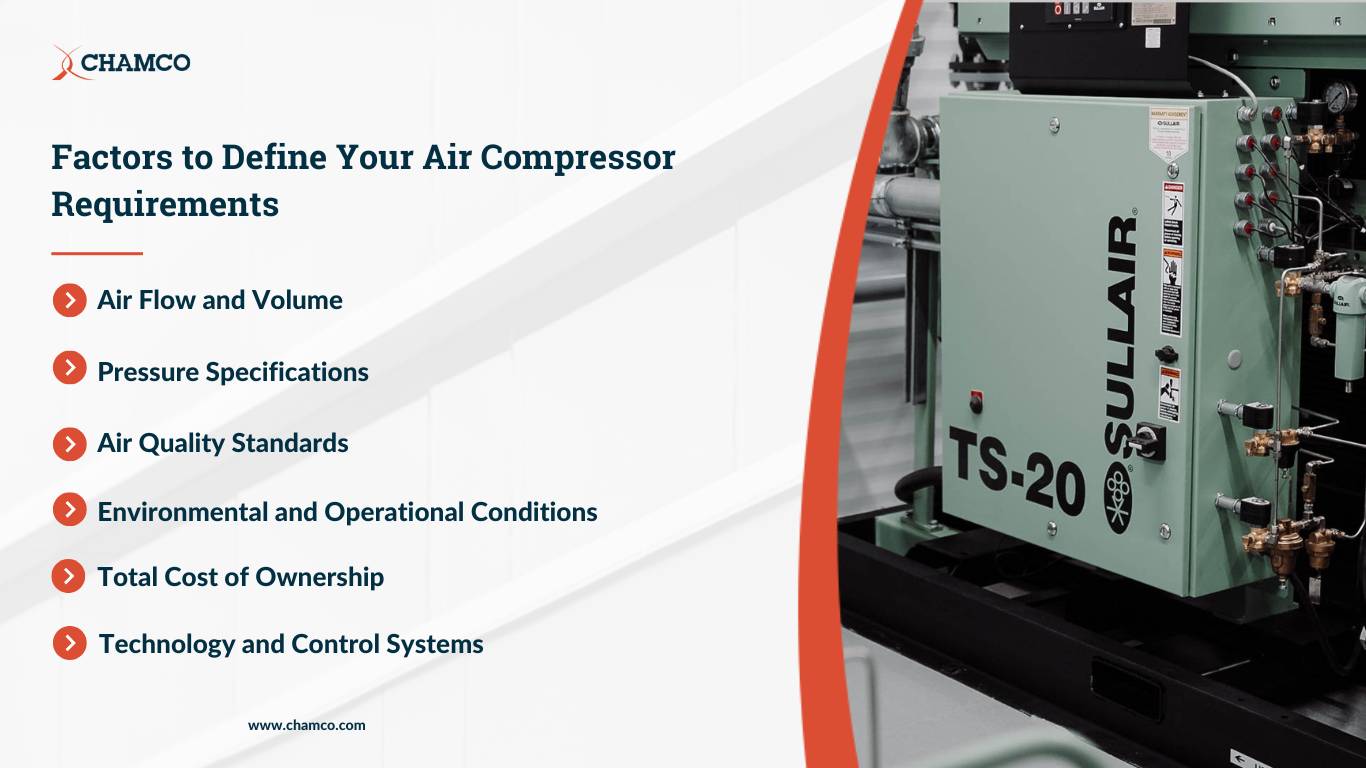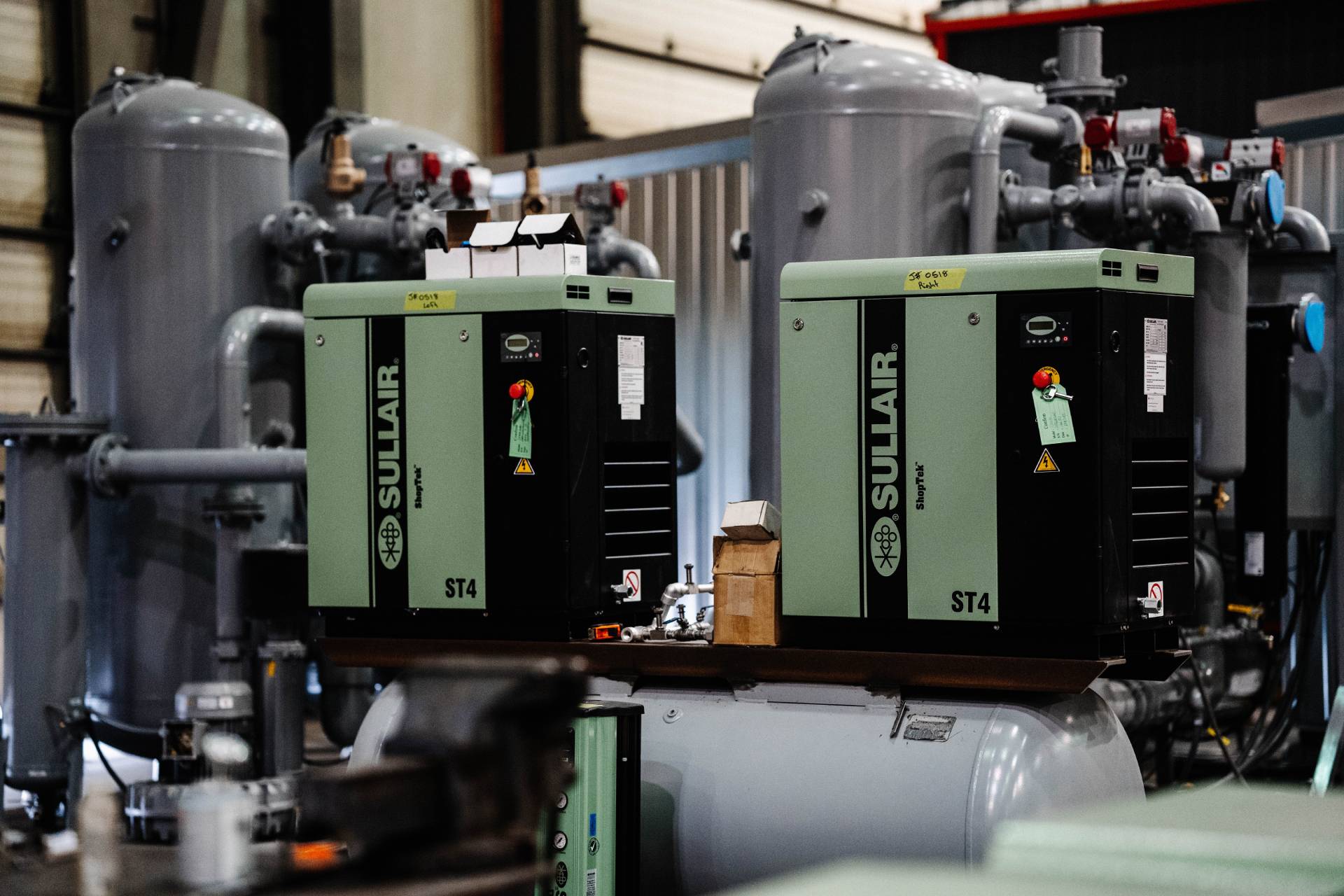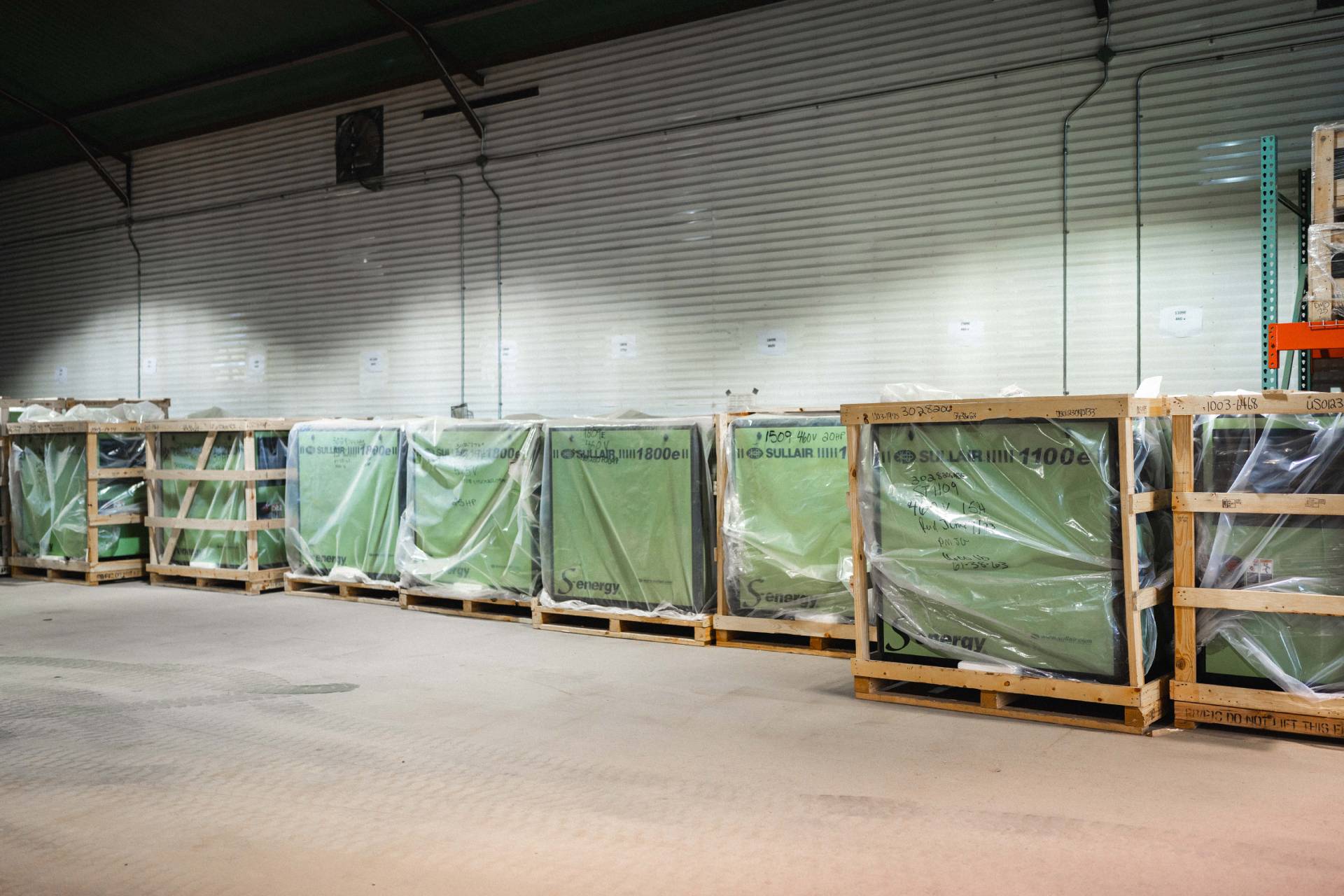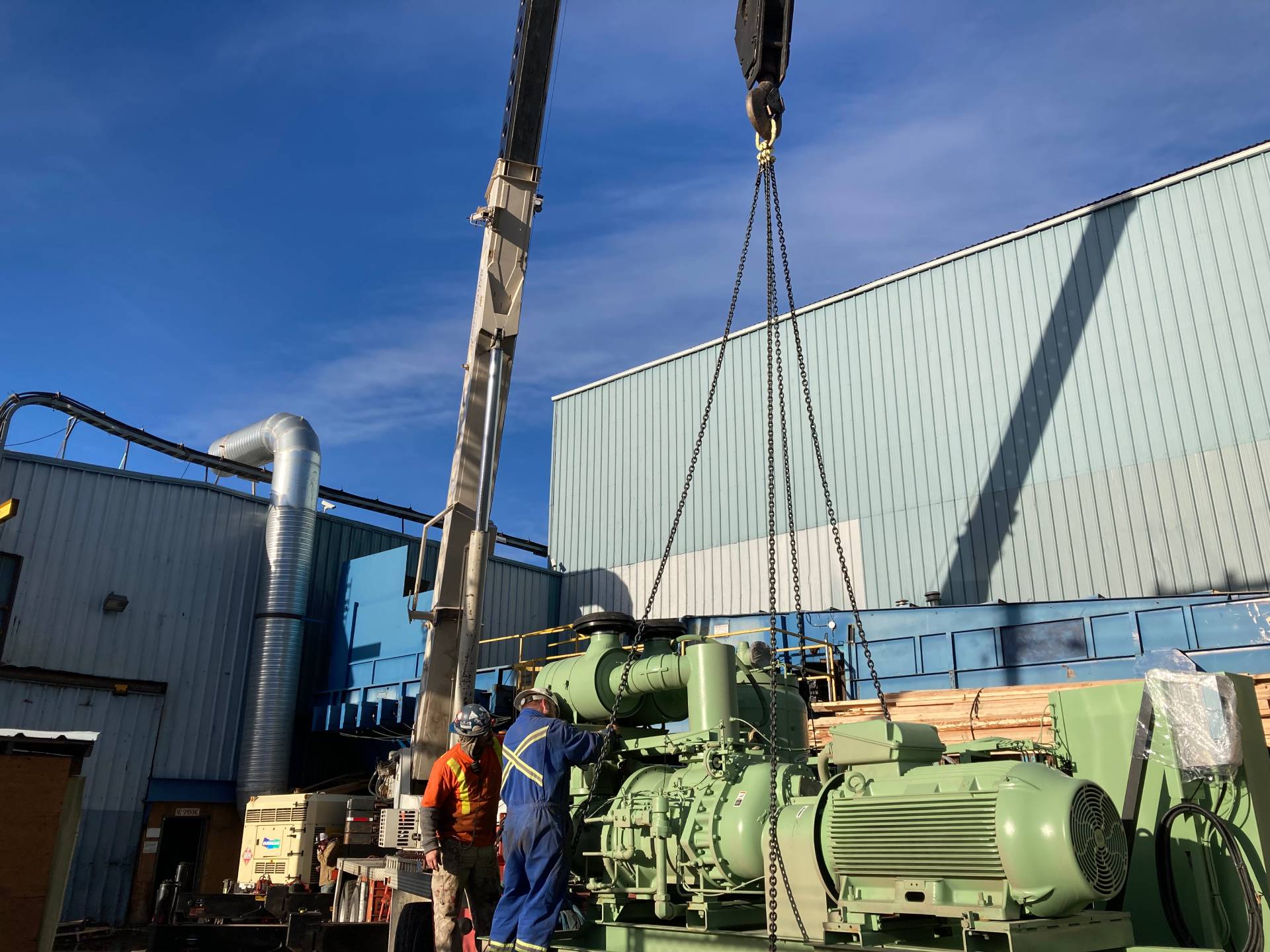Selecting the right industrial air compressor is one of the most critical decisions for your facility’s operations.
Yet, compressed air systems remain one of the least understood systems in industrial environments.
While most people have a basic understanding of water, power, and gas utilities, compressed air systems present a significant knowledge gap that can lead to costly mistakes.
Essential Factors to Define Your Air Compressor Requirements
The foundation of any successful compressor selection begins with one fundamental question: Why do you need compressed air?
Before evaluating equipment specifications or comparing vendors, it’s important to define your application requirements. This approach prevents the common pitfall of selecting equipment based on assumptions rather than actual needs.

Required Air Flow and Air Volume
Your compressed air demand is the foundation of your system design.
Begin by calculating the airflow in cubic feet per minute (CFM) required to meet all operational needs, and consider how this demand fluctuates throughout your production cycle.
Then, determine whether your application requires a continuous air supply or if stored air can cover peak demand periods.
Pressure Specifications
Map out the pressure requirements across all your applications.
Different processes often require different pressure levels, and identifying the minimum and maximum air pressures needed prevents costly oversizing. Don’t let one high-pressure application drive your entire system design when most of your facility operates at lower pressures, because there are more efficient ways to handle varied pressure needs.
Air Quality Requirements
Unlike other utilities that deliver standardized quality, compressed air quality should match your specific process needs.
Carefully evaluate what level of filtration, drying, and separation your processes require rather than defaulting to the most expensive compressor type out of caution. For example, many facilities automatically assume they need oil-free compressed air when oil-lubricated compressed air would work perfectly for their industrial applications.
Environmental and Operational Factors
Your facility environment impacts equipment selection and long-term reliability.
Document operating temperature ranges, dust levels, humidity conditions, available space, and noise restrictions. Understanding these factors is important for choosing an air compressor that is well-suited to specific industrial settings.
Total Cost of Ownership
The initial equipment cost represents just one component of your air compressor investment.
It’s worthwhile to factor in energy efficiency, operating costs, maintenance requirements, and the expected lifespan of your air compressor because these factors directly affect your total cost of ownership and return on investment.
Additionally, researching available government incentives can significantly offset higher initial costs for more efficient equipment.
Technology and Control Systems
Choosing the right control technology is also critical to your industrial compressor’s performance and reliability.
For example, Variable Frequency Drive (VFD) compressors offer excellent energy efficiency under ideal conditions. However, if your facility faces challenges such as unstable power supply, high elevation, dusty environments, or extreme temperatures, VFDs may lead to higher maintenance costs and reliability issues. In these cases, alternative control technologies, such as spiral valve systems, can provide more suitable efficiency benefits with less complexity.
Mistakes to Avoid When Choosing an Air Compressor
Understanding common pitfalls in compressor selection can save you significant money and prevent long-term operational headaches. These mistakes happen frequently across industries, but they’re entirely preventable with the right approach.
The Assumption Trap
The most expensive mistake companies make is basing compressor selection on assumptions rather than actual requirements.
For example, many large industrial facilities automatically purchase an oil-free compressor when a less expensive oil-flooded air compressor would be best. This decision typically stems from risk aversion and a lack of education about what elements are needed for successful operation.

Before defaulting to premium options, we encourage you to take time to understand whether your process truly requires oil-free air or if standard compressed air with appropriate filtration will meet your needs.
Oversizing Problems
Without a thorough facility assessment, companies often oversize their compressor systems, resulting in higher upfront costs, lower operational and energy efficiency, unnecessary maintenance, and inefficient compressor system layouts.
The common impulse to “go bigger to be safe” can backfire, even when planning for future expansion. Taking the time to define your actual requirements can save thousands in long-term expenses and improve overall efficiency.
Not Using Third-Party Information
Relying on credible sources ensures you’re making an informed investment, not just a hopeful guess.
Without third-party validation, there is no guarantee that the performance data reflects real-world industrial conditions. That’s why it’s important to ask your air compressor distributor for independently verified information, such as standardized Compressed Air & Gas Institute datasheets, which provide accurate comparisons of flow, power consumption, and efficiency across manufacturers.
Regulatory Compliance Oversights
Overlooking regulatory requirements can cause delays, fines, or safety issues.
In several Canadian provinces, including Alberta and British Columbia, it’s the end-user’s responsibility to ensure that all installed equipment complies with provincial regulations.
If a vendor’s proposal doesn’t specifically mention required certifications, there’s a good chance they don’t have them. Always confirm that certifications are clearly stated and included in your air compressor purchase order.
Chamco’s Consultative Process To Help You Choose the Right Air Compressor

At Chamco, our education-first approach ensures you make informed decisions based on facts rather than assumptions. Whether you’re replacing existing equipment, expanding operations, or designing a new facility, investing in proper assessment and consultation pays dividends in compressor reliability, efficiency, and long-term operational success.
Discovery and Understanding
We approach every facility with genuine curiosity about your business operations. Our goal is to understand how you work so we can suggest compressor solutions that align with your operational requirements. This discovery includes identifying all compressed air applications, evaluating current system performance, and discussing long-term operational goals.
Analysis and Strategy Development
Every compressed air system can be designed in multiple ways. We examine different approaches, compare the pros and cons of various strategies, and consider unique solutions that match your specific environment.
Solution Presentation and Partnership
We present all available options, not just what we sell. This includes an honest assessment of what we can and cannot do, a transparent discussion of system limitations and benefits, and clear explanations of how different approaches affect your total cost of ownership.
Ongoing Support and Optimization
Our relationship continues after installation. We provide commissioning services to verify that your industrial air compressor performs as expected, including monitoring and adjusting settings to optimize performance. For example, if we initially designed for 110 PSI operation, we’ll adjust to 105 or 115 PSI if that proves more effective for your specific application. Throughout the lifecycle of your compressor, we also provide maintenance services and genuine OEM parts.
Finding the Perfect Industrial Air Compressor For Your Unique Requirements

Selecting the right industrial air compressor requires more than comparing specifications and prices. It demands a thorough understanding of your operational requirements, a transparent assessment of available technologies, and a partnership with knowledgeable professionals who prioritize your long-term success.
At Chamco, we’ve spent over six decades helping clients across Western Canada navigate these complex decisions and understand there’s no one-size-fits-all solution.
So, when you’re ready to discuss your compressed air requirements, our experienced team will provide a comprehensive assessment of your industrial air compressor needs. Contact us today to get started.